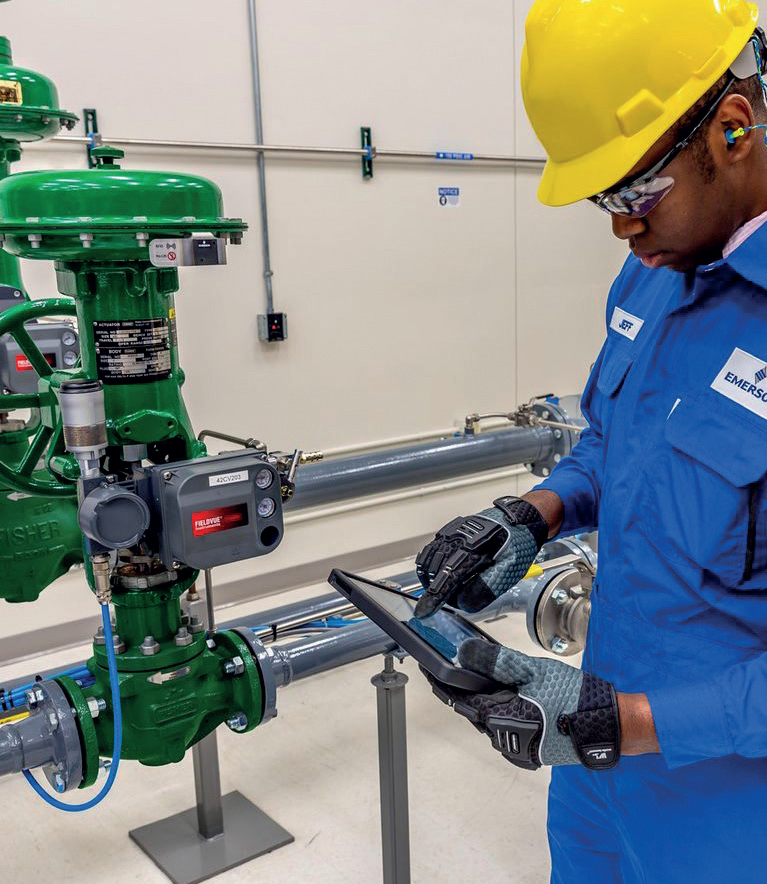The industrial market is constantly evolving to meet the ever-changing needs of each respective industry. This is no different in the valve and actuator industry. Technology is continuously progressing to keep up with the latest requirements and trends, as is demonstrated by the constant wave of new products and greener processes designed with the goal of mitigating fugitive emissions.
Valve World Americas had the pleasure of speaking with Michael Calaway, Vice President of Product Management for Actuation Technologies at Emerson, to discuss his thoughts on the current industrial market and how applications are progressing to address the current pain points and challenges faced in the industry.
By KCI Editorial
Michael Calaway discovered his interest in the industrial sector while studying as an intern with ConocoPhillips. After graduating with an Electrical Engineering degree from Texas Tech University, he began his career as an engineer with ExxonMobil. There, he focused on instrumentation, controls, and operations at various refineries, before accepting a role with Emerson. Today, Calaway oversees strategic planning for the actuation portfolio for Emerson, as the Vice President of Product Management for Actuation Technologies.
“I work with my team to identify current needs and trends in the industry and develop product strategies to help meet those needs today, as well as in the future,” detailed Calaway. When asked to describe a typical working day in his role, he chuckled, “there is no such thing.” Of course, there are certain daily goals that fall into his position.
“When I was working as an engineer, I always loved solving problems. Now I love the people development side of the business,” said Calaway. “Trying to understand people and where they should go, putting them in the right spot at the right time to ensure end users are getting the solutions they need is very rewarding.” Still, even in his management position, Calaway is involved in the engineering process. “It is a collaborative effort with a team of product managers and leaders,” explained Calaway. “At the end of the day, our ideas come from everyone everywhere. I spend a significant amount of time determining what types of products are most needed, where they must go, and then the rest of the time executing that strategy.” This involves a thorough understanding of the current market, the factors that drive it, as well as the needs of the end users.

Evolving Markets
With over eight years of experience in product marketing, Calaway has gained first-hand knowledge of how quickly a situation can evolve, and the effect both small and large changes can have on every facet of the industry.
“COVID-19 notwithstanding, the market has gone through quite the evolution,” said Calaway. “Trends were on a path that led to the establishment of ‘greener’ processes, and then the Ukraine conflict began. This caused a resurgence of reliance on oil and gas, which has in turn led to a re-emergence of older products. As the push for lower-emission products is still, however, very prevalent, the industry is struggling to find the balance between the products. Past projections had not anticipated as much of a demand for both new lower emissions products and products that will facilitate oil and gas production.”

“While some places are very slow to react or adopt regulations, taking a proactive stance and looking at applications that are not generally considered a significant source of fugitive emissions, such as actuators, and optimizing them to better aid the applications that do leak, such as valves, can make a significant difference in achieving these goals.”
Application Advancement
There has been renewed interest in the upstream oil & gas market as of late, which has led to a renewed focus on developing products that not only meet but exceed emissions requirements.
“If looking at an actuator, for example, historically, we were okay with bleeding devices; we really did not think too much about it,” explained Calaway. “When we started to focus on emissions, however, we realized that actuators powered by natural gas were bleeding a significant amount of volatile organic compounds (VOCs) into the atmosphere.”
While pneumatic actuators have traditionally been used for upstream applications, the push for net zero emissions has led many end users to look at electric and hydraulic actuators as alternative solutions. Today, however, pneumatic actuators are still the most viable option for certain upstream applications. “With an electric actuator, you are turning a gear. With a pneumatic one, you are not. Getting the correct speed to open and close a valve and prevent leaks becomes a challenge,” said Calaway. “There are some applications, such as emergency shut-off and anti-surge valves, where it is vital that the valve open and close within seconds. There is no room for error.”
There is still a way to go when it comes to engineering development and the ability to significantly reduce or eliminate actuator emissions, but Calaway is optimistic. “The advance of technology around electric and hydraulic actuation has progressed a lot over the last five years,” said Calaway, “and I think within the next five years, we will have a really good handle on it.”
Looking Forward
A significant amount of innovation and inventive measures will be necessary to achieve the net zero goals that have been mandated. “I believe we will be able to achieve them,” expressed Calaway, “but meeting the net goals is going to happen a lot slower than people may want. It would be a technological feat to meet some of the projected dates out there. There will always be some form of emissions in the future that we will try to overcome, but at the end of the day I think we will have a much healthier world.”
By setting very aggressive goals, Calaway believes that more individuals will be motivated to make the necessary changes to achieve a greener future. “While some places are very slow to react or adopt regulations, taking a proactive stance and looking at applications that are not generally considered a significant source of fugitive emissions, such as actuators, and optimizing them to better aid the applications that do leak, such as valves, can make a significant difference in achieving these goals.”
“Actuation is a lot more exciting than people think,” chuckled Calaway. “There is a lot of fun in this industry. We are forever thinking of how to evolve and trying to find cutting-edge technology to take us to that next level.”



